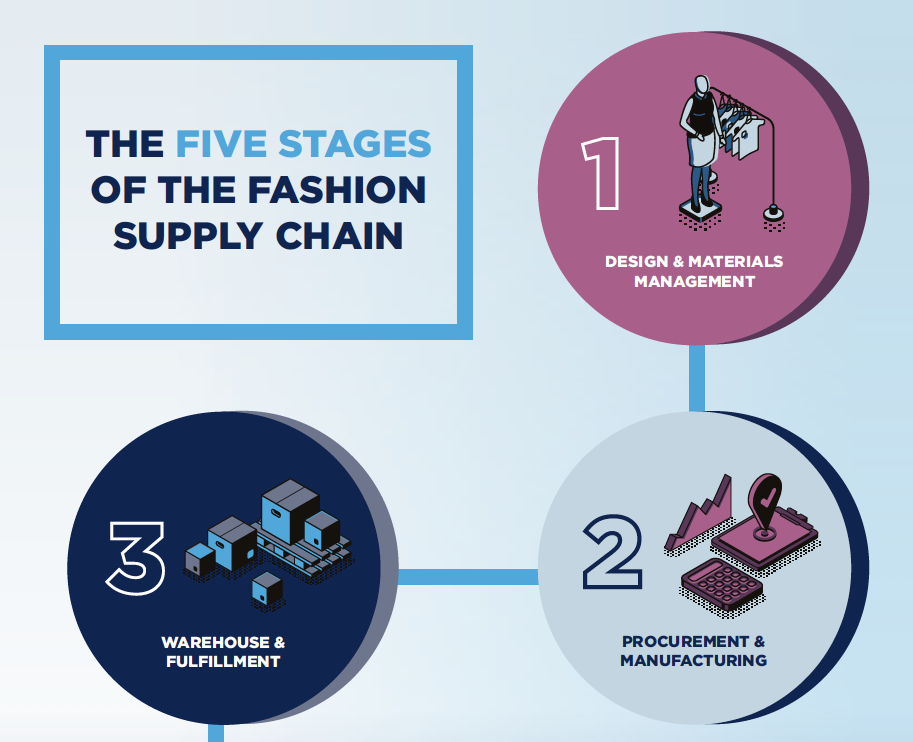How to Leverage Technology in the Era of Fast Fashion
by Alexis Borucke | August 6, 2020

Today more than ever, fashion, apparel and textile companies are looking for the best ways to optimize their supply chain. The reason is simple; an agile and efficient supply chain is key to survival in uncertain times. Access to real-time information gives brands and manufacturers a competitive edge and supply chain technology is essential to ensure you can manage information effectively at every stage of design, manufacturing and distribution. If your organization is trapped in a siloed, inflexible supply chain, it’s nearly impossible to pivot and adapt to shifting market conditions.
Below is an overview of the five key stages of the fashion, apparel and sewn goods supply chain and the specific technologies successful companies leverage to boost productivity and plan proactively to deliver goods to their customers through times of market disruption.
Stage 1: Design and Materials Management:
In order to keep up with the latest trends, your products need to get to the market as fast as possible. In order for this to happen, you must maintain an efficient process of designing and selecting materials, which includes a lot of back and forth communication, sourcing and sample tracking.
Recommended Solution: Product Lifestyle Management (PLM)
Stage 2: Procurement and Manufacturing:
When design and style is complete, it’s time to source vendors and procure materials needed for Manufacturing, including textiles, thread, embellishments and closures. The goal is to find the highest quality materials produced by very reliable vendors at the best price.
Recommended Solutions: Product Lifestyle Management (PLM), Enterprise Resource Planning (ERP), and Shop Floor Control (SFC)
Stage 3: Warehouse and Fulfillment:
After manufacturing, finished products will be received at one or more warehouses that may be operated by the fashion brand company or a third-party logistics (3PL) operation. When goods come into the warehouse, they need to be accurately identified, counted and put away in the right location, as well as real-time visibility into their entire inventory in stock.
Recommended Solutions: Shop Floor Control (SFC), Third Party Manufacturing (3PM) and Warehouse Management System (WMS)
Stage 4: Distribution:
When it is time to fulfill orders for retailers, warehouse workers need to be directed to the right locations to pick the correct items in the correct quantity. Items and orders need to be labeled and shipped according to retailer requirements.
Recommended Solutions: Electronic Data Interchange (EDI), Warehouse Management System (WMS), Vendor Portal Management.
Stage 5: Repairs and Returns:
Flawed goods or merchandises that have reached their ‘end of lifetime’ will be returned. Managing the returns stage of the supply chain requires working with partners and retailers to identify condition, authorize returns, schedule shipments, and issue refunds.
Recommended Solutions: Vendor Portal Management, Warehouse Management System (WMS)
Technology is key to driving the visibility, speed and accuracy required to adapt to evolving customer demands and a changing competitive landscape. Better supply chain management helps get products to customers faster which boost profitability. Vendors taking advantage of a cohesive end-to-end Supply Chain Management technology platform will be able to bring a higher quality product to market faster than ever before, with less waste and fewer returns. With our consistent leadership in PLM, Shop Floor Control, ERP, EDI, WMS, Third-Party Manufacturing, and Vendor Portals applications, Exenta has built a supply chain solution for the fashion and the soft good industry using real-time visibility across the entire supply chain.
Interested in learning more about technology and the supply chain? Download our white paper: Automating the Fashion Supply Chain. Ready to take the next step to elevate your supply chain? Schedule a custom demo today!

